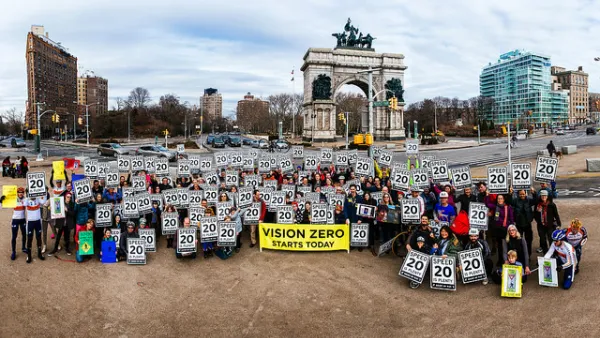Traffic fatalities are on pace to reach 35,000 in the United States this year. Some advocates are saying it's time for traffic engineers to stop blaming the victims.
"US traffic deaths are rising again—fatalities jumped 8.1 percent in the first half of 2015, National Highway Traffic Safety Administration (NHTSA) reports," according to an article by Robert Steuteville.
Steuteville notes that the NHTSA cites "drunken, drugged, distracted and drowsy driving; speeding; and failure to use safety features such as seat belts and child seats," for the increase in tragedy, but he wishes they'd acknowledge another D—the "design of streets and communities." When it comes to design, argues Steuteville, the "bigger is better" approach always wins out—even when all evidence suggests that smaller lanes reduce risks.
"The NHTSA reaction to the current trend in fatalities shows that evidence continues to be ignored. Not everywhere: In the alphabet soup of agencies that govern streets and highways, the Federal Highway Administration (FHWA) recently admitted that wider lanes have no safety benefit on thoroughfares designed for less than 50 mph. This is a small step in the right direction, given that wider lanes degrade safety in urban conditions. It is time for transportation engineers to look in the mirror, own up to the damage done to people and communities, and disavow once and for all the 'bigger is better' approach to urban thoroughfares."
The article surveys some of the influential studies that make the case for a design solutions that could start reducing the loss of life on U.S. streets, roads, and highways before arriving to that frank conclusion. Of particular interest in the definitive 2008 study by Garrick and Marshall, which found that newer cities in California laid out with wider streets and longer blocks have three times more traffic fatalities per capita than cities built before 1950.
That Garrick and Marshall study was also of particular interest to Angie Schmitt at Streetsblog, who deserves a hat tip for sharing this article.
FULL STORY: As traffic deaths rise, blame engineering dogma

Analysis: Cybertruck Fatality Rate Far Exceeds That of Ford Pinto
The Tesla Cybertruck was recalled seven times last year.

National Parks Layoffs Will Cause Communities to Lose Billions
Thousands of essential park workers were laid off this week, just before the busy spring break season.

Retro-silient?: America’s First “Eco-burb,” The Woodlands Turns 50
A master-planned community north of Houston offers lessons on green infrastructure and resilient design, but falls short of its founder’s lofty affordability and walkability goals.

Test News Post 1
This is a summary

Analysis: Cybertruck Fatality Rate Far Exceeds That of Ford Pinto
The Tesla Cybertruck was recalled seven times last year.

Test News Headline 46
Test for the image on the front page.
Urban Design for Planners 1: Software Tools
This six-course series explores essential urban design concepts using open source software and equips planners with the tools they need to participate fully in the urban design process.
Planning for Universal Design
Learn the tools for implementing Universal Design in planning regulations.
EMC Planning Group, Inc.
Planetizen
Planetizen
Mpact (formerly Rail~Volution)
Great Falls Development Authority, Inc.
HUDs Office of Policy Development and Research
NYU Wagner Graduate School of Public Service




























